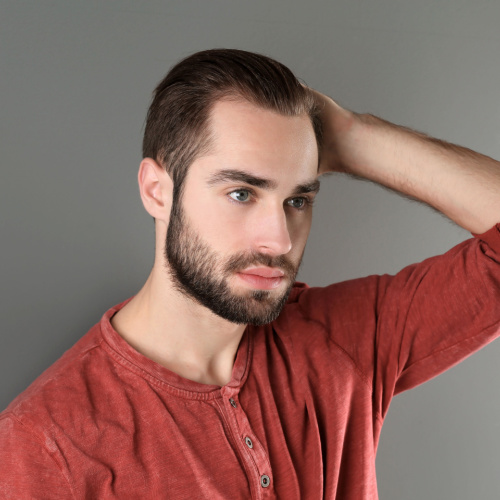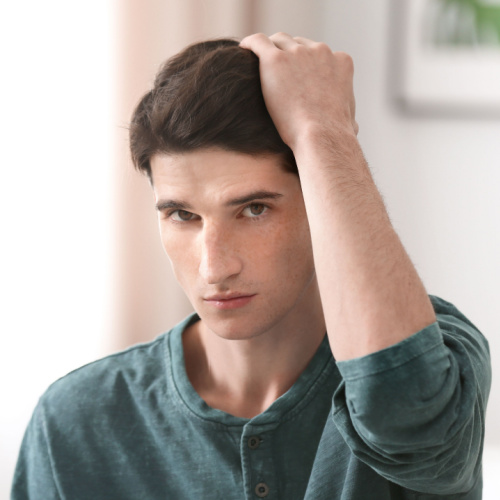What Is Causing Your Hair Loss?
Hair loss happens naturally to most people every day. That said, if you’re experiencing consistent balding or thinning hair, it can result from several factors. Male pattern baldness is often the most common cause of hair loss in adult men. However, you can also lose hair if you have thyroid disease or Polycystic Ovarian Syndrome (PCOS).
Additionally, hair loss can occur due to the following causes:
- Alopecia areata
- Stress
- Telogen effluvium (TE)
- Traction alopecia
- Lichen planus
- Lichen planopilaris
- Dermatitis
- Alopecia Areata
- Alopecia totalis
- Melanoma
- Auto-immune conditions
What Are the Best Hair Restoration Treatments Available?
No matter where you are in your journey, Dr. Golio and our team will walk you through your options for hair restoration. We’ll review medications for hair growth as well as surgical hair transplant procedures with you so you know your options and can decide on the best course of action for your hair restoration needs.
Medications for Natural Hair Growth
If you’re navigating male pattern baldness or thinning hair and looking for a nonsurgical option to hair restoration, two medications can help. Minoxidil and Finasteride are commonly used to treat hair loss and stimulate hair regrowth.
Minoxidil, previously known as Rogaine, is a topical medication that can also be prescribed as a tablet. Minoxidil is applied directly to the scalp in its topical use, expanding your blood vessels to encourage new growth.
Finasteride is a pill taken orally that stops testosterone from turning into dihydrotestosterone, a hormone that can cause hair loss. By taking Finasteride, you can slow hair loss and promote new hair growth.
Hair Restoration Surgery and Procedures
If medications and supplements don’t work for you, that doesn’t mean your aesthetic hair goals are out of reach. Several hair restoration surgeries and procedures can help you achieve the look and feel you want for your hair.
Follicular Unit Transplantation (FUT)
FUT is a type of hair transplant surgery, also known as “hair plugs,” where your hair doctor removes a strip of healthy hair follicles from the back of your head. This donor hair is then transplanted to the thinning areas of the scalp, called the recipient sites. You’ll be under anesthesia for the procedure, which typically lasts between four and eight hours.
Follicular Unit Extraction (FUE)
FUE hair transplantation surgery removes individual hairs, instead of a strip of hair like FUT. These grafts are then transplanted to fill in the thinning or bald area of the scalp. Depending on your current hair loss, the FUE method can be preferable as it doesn’t leave much, if any, scarring and blends easily with your remaining hair.
Facial Hair Transplants
If you’re looking for thicker or more symmetrical eyebrows, a fuller beard, or a goatee that makes a statement, facial hair transplants could be a great option for you. Your hair surgeon Dr. Golio will remove healthy hair follicles from your head and transplant them to the area of your face you’d like to see new hair growth.
Scalp Micropigmentation (SMP)
SMP is similar to a tattooing process and can take several sessions. However, the microneedling tool that’s used doesn’t penetrate as deeply into the skin as a traditional tattoo. In your first treatment session, your hair technician injects pigment into your scalp to mimic naturally growing hair.
Platelet-Rich Plasma (PRP) Therapy
PRP therapy can be used with other hair restoration procedures or on its own to promote hair growth. The process involves injecting your platelets into the places where you have damaged follicles or thinning hair to enhance your hair transplant results or encourage the development of new healthy hair follicles.
Female Hair Restoration
At The Hair Transplant Center – New Jersey, we’re proud to offer hair transplant services to patients of all genders, including our female hair restoration services. Our hair doctor will do a thorough consultation to discuss your aesthetic concerns and recommend the right hair restoration treatment for you.
PDO Threads
PDO Threads are polydioxanone sutures used with other hair transplant procedures to promote hair growth. This process helps improve blood flow and contributes to the production of collagen, hyaluronic acid, and elastin. Because PDO Threads stimulate your body’s natural platelet response, new hair begins to grow.
Stem Cell Grafting
Stem Cell Grafting can be combined with other hair reconstructive surgeries or PDO Threads and involves harvesting tissue from the back of your head. Stem cells are then extracted from using Stromal Vascular Fraction (SVF) and injected into areas that need help with healing and regrowth.

